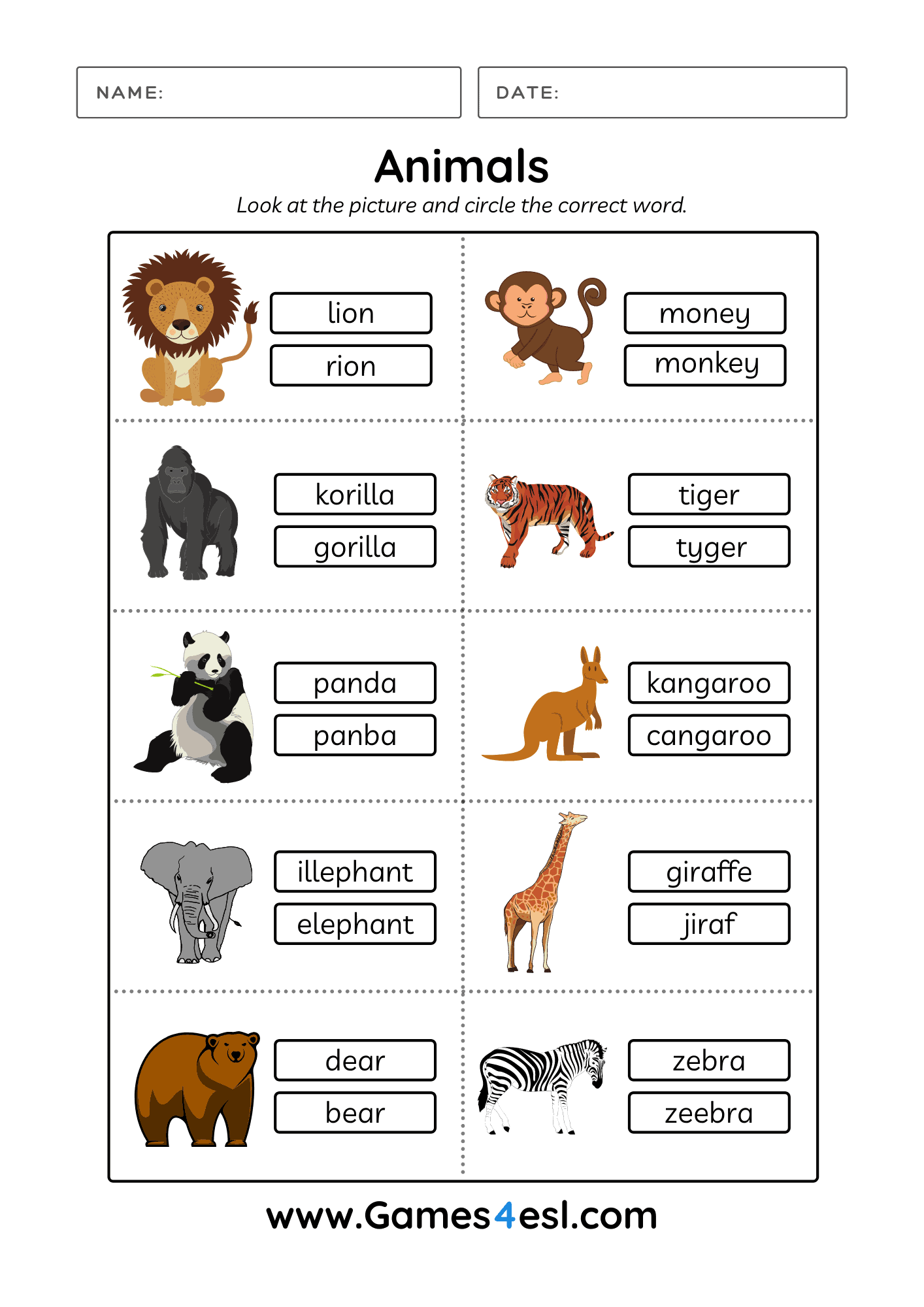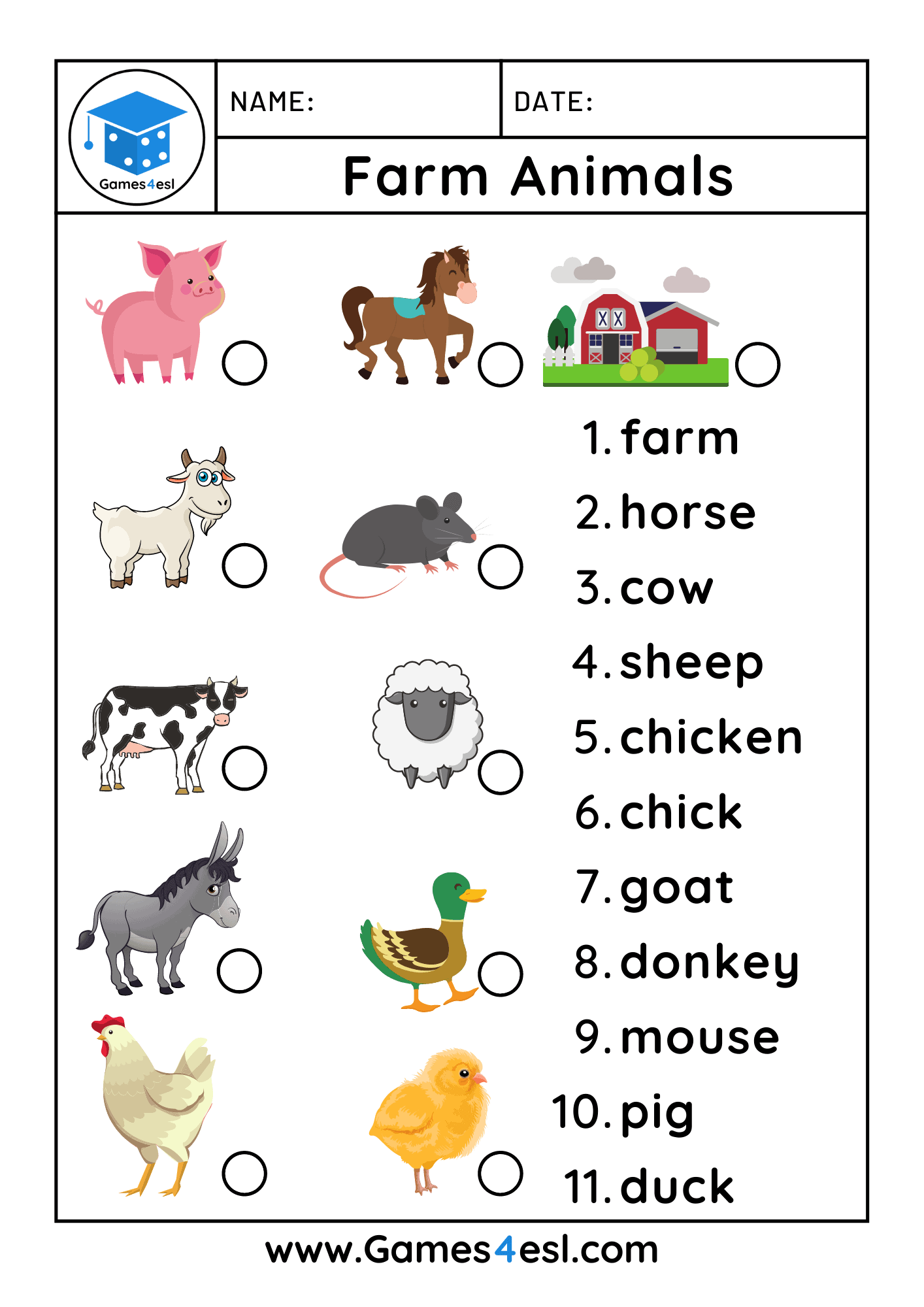Unleashing Learning: The Enduring Power of Animal Vocabulary Worksheets
The natural world, with its incredible diversity of creatures, has always captivated human curiosity. From the roaring lion to the tiny ant, animals offer a rich tapestry of life that sparks imagination and wonder. For educators and parents alike, harnessing this innate fascination presents a powerful opportunity to foster language development, particularly in vocabulary acquisition. In this context, animal vocabulary worksheets emerge as an invaluable tool, providing structured, engaging, and effective pathways for learners of all ages to expand their lexicon and deepen their understanding of the living world.
This article delves into the profound benefits, diverse applications, and strategic implementation of animal vocabulary worksheets, exploring why they remain a cornerstone of effective language education. We will examine their adaptability across various age groups and learning levels, discuss the myriad of formats they can take, and offer insights into maximizing their educational impact, ultimately empowering learners to articulate the wonders of the animal kingdom with precision and confidence.
The Undeniable Value of Animal Vocabulary Worksheets

At their core, animal vocabulary worksheets are designed to introduce, reinforce, and assess knowledge of words related to animals. Their significance, however, extends far beyond simple word recognition.

- Inherent Engagement: Animals are universally appealing. Children are naturally drawn to their sounds, movements, and diverse appearances. This intrinsic interest transforms what might otherwise be a tedious vocabulary lesson into an exciting exploration. When learning is enjoyable, retention rates skyrocket.
- Contextual Learning: Words are rarely learned effectively in isolation. Animal vocabulary worksheets provide a natural, relatable context for new terms. Instead of just memorizing "mammal," a student learns it in relation to a lion, a whale, or a bat, understanding its characteristics within a broader biological classification. This contextualization aids comprehension and long-term recall.
- Cognitive Development: Engaging with these worksheets stimulates various cognitive processes. Matching activities enhance visual discrimination and memory. Fill-in-the-blank exercises encourage critical thinking and deductive reasoning. Crosswords and word searches improve pattern recognition and problem-solving skills.
- Versatility and Adaptability: From preschoolers learning basic animal names to advanced ESL students grappling with collective nouns (a "pride" of lions, a "parliament" of owls) or scientific classifications, animal vocabulary worksheets can be tailored to suit any age or proficiency level. This adaptability makes them a staple resource in diverse educational settings.
- Reinforcement and Repetition: Language acquisition thrives on repetition. Worksheets offer a structured way for learners to encounter new words multiple times through various activities, solidifying their understanding and embedding them into their active vocabulary. They provide a low-stakes environment for practice, allowing students to learn from mistakes without fear of judgment.
- Bridge to Other Subjects: Animal vocabulary naturally intersects with science (biology, ecology), geography (habitats, migration), and even social studies (conservation, human-animal interaction). By learning animal-related terms, students build a foundational vocabulary that supports understanding in these interconnected disciplines.




Target Audience and Adaptability Across Learning Levels
The beauty of animal vocabulary worksheets lies in their scalability. Their content and complexity can be meticulously adjusted to cater to different developmental stages and language proficiencies.

- Young Learners (Preschool & Kindergarten): For this group, worksheets focus on basic animal names (e.g., dog, cat, cow, bear), animal sounds, and simple descriptions (e.g., "big," "small," "furry"). Activities often involve matching pictures to words, coloring, tracing letters, or identifying animals from a group. The emphasis is on visual recognition and auditory association.
- Elementary School (Grades 1-5): As students progress, the vocabulary expands to include more specific animal types (e.g., amphibians, reptiles, insects), basic habitats (e.g., jungle, ocean, desert), and simple actions (e.g., run, swim, fly). Worksheets might incorporate fill-in-the-blank sentences, simple definitions, word scrambles, or categorization tasks (e.g., sorting animals into groups like "farm animals" and "wild animals").
- Middle School (Grades 6-8): Here, the focus shifts to more nuanced vocabulary. Students might learn about animal adaptations (e.g., camouflage, hibernation), diets (e.g., herbivore, carnivore, omnivore), collective nouns, and more detailed descriptions of animal behavior. Worksheets could include reading comprehension passages followed by vocabulary questions, matching scientific terms to common names, or creating sentences using new words.
- High School and Adult ESL Learners: For advanced learners, animal vocabulary worksheets can delve into specialized terminology, figurative language (e.g., "as strong as an ox," "a lone wolf"), idioms related to animals (e.g., "let the cat out of the bag," "dog eat dog world"), and even scientific nomenclature. Activities can involve critical analysis of texts, debates on animal welfare, or creative writing incorporating advanced animal vocabulary. The complexity of these animal vocabulary worksheets can truly stretch a learner’s linguistic capabilities.


Types of Engaging Animal Vocabulary Worksheets
The format of an animal vocabulary worksheet can significantly impact its effectiveness and the type of learning it promotes. Here are some popular and highly effective formats:
-
Matching Worksheets:
- Picture to Word: Students draw lines connecting images of animals to their written names. Ideal for young learners.
- Word to Definition: Matching animal names to short descriptions or characteristics (e.g., "Lion" to "A large wild cat, often called the king of the jungle").
- Animal to Habitat: Matching an animal to its natural environment (e.g., "Fish" to "Ocean").
-
Fill-in-the-Blanks:
- Sentence Completion: Students complete sentences using appropriate animal vocabulary from a word bank (e.g., "The __ barks loudly." Answer: "dog").
- Fact Completion: Filling in facts about animals (e.g., "A bird lays __." Answer: "eggs").
-
Word Searches and Crosswords:
- Word Searches: Fun for identifying and recognizing animal names within a grid of letters.
- Crosswords: Excellent for reinforcing spelling and definitions, as clues lead to animal names or related terms.
-
Labeling Diagrams:
- Animal Anatomy: Labeling parts of an animal (e.g., "wing," "beak," "claw" on a bird diagram).
- Habitat Diagrams: Labeling different animals found in a specific ecosystem.
-
Categorization/Sorting Activities:
- By Type: Sorting animals into categories like "mammals," "birds," "fish," "reptiles," "amphibians," "insects."
- By Habitat: Sorting animals into groups like "farm animals," "zoo animals," "ocean animals," "forest animals."
- By Diet: Categorizing as "herbivores," "carnivores," or "omnivores."
-
Sentence Creation/Writing Prompts:
- Students use new animal vocabulary words to create their own sentences.
- Prompts like "Describe your favorite animal using at least five new vocabulary words" encourage creative application.
-
True/False or Multiple Choice:
- Assessing comprehension of animal facts and vocabulary (e.g., "A snake has legs. True/False").
-
Collective Nouns Worksheets:
- Specifically focusing on terms like "a pack of wolves," "a school of fish," "a flock of birds," which are often challenging but enriching.
Crafting Effective Animal Vocabulary Worksheets
To maximize the impact of these educational tools, consider the following best practices:
- Clarity and Simplicity: Instructions should be clear, concise, and easy to understand for the target age group.
- Visual Appeal: Incorporate high-quality, engaging images. Colors, appropriate fonts, and a clean layout make the worksheet inviting and less daunting.
- Relevance and Progression: Ensure the vocabulary is age-appropriate and builds upon prior knowledge. Introduce new words gradually.
- Variety of Activities: Mix different types of exercises within a set of worksheets to maintain engagement and cater to diverse learning styles.
- Scaffolding: Provide support where needed. For younger learners, include word banks. For more advanced students, challenge them with open-ended questions.
- Answer Keys: Always provide an answer key, especially for self-paced learning or homework. This allows students to check their work and learn from their mistakes immediately.
- Differentiation: Prepare slightly easier and harder versions of the same worksheet to accommodate different learning paces and abilities within a classroom.
- Real-World Connections: Whenever possible, connect the vocabulary to real-world examples, discussions, or experiences (e.g., "Have you ever seen a squirrel burying nuts?").
Integrating Animal Vocabulary Worksheets into the Curriculum
Worksheets should not exist in isolation. Their true power is unleashed when integrated seamlessly into a broader curriculum:
- Pre-reading/Post-reading Activities: Use worksheets to pre-teach vocabulary before reading an animal-themed story or non-fiction text, or as a post-reading activity to reinforce new words encountered.
- Science Lessons: Directly link worksheets to units on ecosystems, animal classification, life cycles, or adaptations.
- Geography: Explore animals native to different continents or biomes, using maps and worksheets to reinforce geographical and zoological terms.
- Art Projects: Students can draw animals and then label their body parts using vocabulary from a worksheet, or create a habitat diorama with labeled animals.
- Storytelling and Creative Writing: Encourage students to use newly acquired animal vocabulary in their own stories, poems, or descriptive paragraphs.
- Interactive Games: Transform worksheet content into interactive games like bingo, charades, or "I Spy" to add a dynamic element to learning.
Beyond the Worksheet: Extending Learning
While animal vocabulary worksheets are potent tools, they are part of a larger ecosystem of learning. To truly embed the vocabulary and foster a deeper understanding, consider these extensions:
- Field Trips: A visit to a zoo, aquarium, or local farm provides invaluable real-world exposure to animals and their characteristics.
- Documentaries and Videos: Visual media can bring animals to life, allowing students to observe behavior, habitats, and sounds, reinforcing learned vocabulary.
- Guest Speakers: Invite a zookeeper, veterinarian, or local animal rescue volunteer to share their experiences and specialized vocabulary.
- Class Discussions and Debates: Engage students in discussions about animal conservation, ethical treatment, or fascinating animal facts.
- Research Projects: Encourage students to choose an animal and research its characteristics, habitat, diet, and unique behaviors, presenting their findings using new vocabulary.
- Creative Projects: Students can create animal masks, puppets, or models, using their vocabulary to describe their creations.
Conclusion
The journey of language acquisition is continuous, and vocabulary forms its very backbone. For many learners, the world of animals offers an accessible, captivating entry point into this journey. Animal vocabulary worksheets, in their myriad forms, serve as a foundational resource, providing structured practice, fostering engagement, and building a robust lexicon that extends beyond simple naming.
By leveraging the inherent appeal of the animal kingdom, educators and parents can transform vocabulary learning from a chore into an adventure. These worksheets not only equip learners with the words to describe the creatures around them but also ignite a deeper curiosity about the natural world, paving the way for scientific understanding, empathetic connection, and a lifelong appreciation for biodiversity. In essence, animal vocabulary worksheets are not just about learning words; they are about opening a window to the wild, one word at a time.

